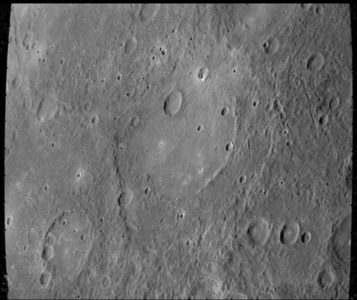Homer is a crater on Mercury. It is one of 110 peak ring basins on Mercury.[1] It is Tolstojan in age.[2]
 Enhanced-color image of Homer, with Dominici crater at top | |
| Feature type | Impact crater |
|---|---|
| Location | Kuiper quadrangle, Mercury |
| Coordinates | 1°18′S 36°37′W / 1.3°S 36.62°W |
| Diameter | 319 km (198 mi) |
| Eponym | Homer |
Deposits of material in and around this crater suggest the possibility of explosive volcanic eruptions at some point in the planet's history.[3] An unnamed crater in northwestern Homer (about 18 km diameter) contains hollows and has dark ejecta.
The crater name was approved by the IAU in 1976.[4] The naming of Stark Y crater on the Moon, located northwest of Stark, as Homer, was not approved by the IAU.[5]
The small but fresh crater Dominici lies along the northern margin of Homer. The crater Handel is to the northeast, and Titian is to the southwest.
-
Mariner 10 image of Homer
-
Homer basin is marked with a white circle in the enhanced-color image. Nearby Titian crater is marked with an arrow.
References
edit- ^ Chapman, C. R., Baker, D. M. H., Barnouin, O. S., Fassett, C. I., Marchie, S., Merline, W. J., Ostrach, L. R., Prockter, L. M., and Strom, R. G., 2018. Impact Cratering of Mercury. In Mercury: The View After MESSENGER edited by Sean C. Solomon, Larry R. Nittler, and Brian J. Anderson. Cambridge Planetary Science. Chapter 9.
- ^ Denevi, B. W., Ernst, C. M., Prockter, L. M., and Robinson, M. S., 2018. The Geologic History of Mercury. In Mercury: The View After MESSENGER edited by Sean C. Solomon, Larry R. Nittler, and Brian J. Anderson. Cambridge Planetary Science. Chapter 6, Table 6.3.
- ^ PSR Discoveries: Hot Idea: Mercury Unveiled
- ^ Homer, Gazetteer of Planetary Nomenclature, International Astronomical Union (IAU) Working Group for Planetary System Nomenclature (WGPSN)
- ^ SEDS: Homer (c. bet. 800 and 700 B.C.)


